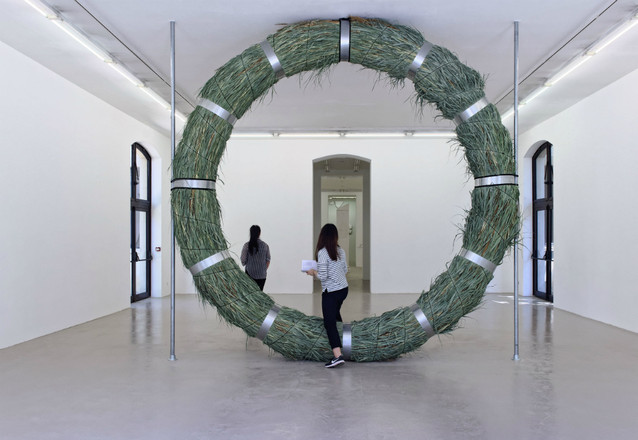La Fête, La Musique, la Noce [Party, Music, Revelry]: War, in the colourful slang of Napoleon’s Grande Armée. This is the proclamation of Maria Loboda’s solo exhibition at the IAC, her largest to date in France. Beneath this quasi-baroque banner, with its whirling tunes evocative of joy and merriment, broods a threat. An underlying tension is felt, settling upon the viewer until the end of the visit.
More interested by history’s flaws and twists than its archaeological evidence or legitimising force, Maria Loboda bases her work on the interpretation and re-appropriation of rituals and, by extension, of symbols belonging to different communities. The artist’s trans-historical reading of myths, of arcane, occult, and alchemical sciences, brings forth iconic forms that interrogate the power or obsolescence of the artefacts invented by humanity in the face of surpassing forces. Nothing lasts forever; nothing is ever exactly as it appears. Full of false likenesses, their aesthetics defying chronological or spatial linearity, Loboda's works reveal their hidden depth inasmuch and insofar as we observe them.
Our system of recognition is constantly baffled, destabilised by the profusion of contradictory and all too human signs. What draws the eye, what the eye recognises, is suddenly opposed by a dissident element, a voluptuous story that twists or distorts its predecessor. We can trust nothing: the fragments of a Gallo-Roman bas-relief lose their recognised logic when we discover in them models of warriors and sealed water bottles (The Wealth of Neolithic Elites, 2017). From titles that promise much – To Separate the Sacred from the Profane, 2016; Tout terriblement, 2017 – to the final breath of In the Long Yawn, 2016, words have the power to conceal more than they reveal. Maria Loboda offers elliptical and enigmatic narratives, troubling the visitor. Her coded installations awaken suspicion through a subtle encrypting whose key could be language.
For this exhibition, the Institute puts on a new look: openings are enlarged, walls and ceilings vaulted, the style oscillates constantly between the sacred (the chapel, the pyramid, the symmetry peculiar to temples, between antechamber and adyton) and the domestic (the corridor, the bourgeois interior, the studio, the boudoir).
In La Fête, La Musique, la Noce, different settings are presented as though on a Cluedo game board, the artworks like the characters of the intrigue. Beneath the attractive surface lurks a barely-checked violence. It won’t be long before the cue-call sounds; the curtain is about to rise; on stage, the teacups are set out, piping hot.
Magalie Meunier
Our system of recognition is constantly baffled, destabilised by the profusion of contradictory and all too human signs. What draws the eye, what the eye recognises, is suddenly opposed by a dissident element, a voluptuous story that twists or distorts its predecessor. We can trust nothing: the fragments of a Gallo-Roman bas-relief lose their recognised logic when we discover in them models of warriors and sealed water bottles (The Wealth of Neolithic Elites, 2017). From titles that promise much – To Separate the Sacred from the Profane, 2016; Tout terriblement, 2017 – to the final breath of In the Long Yawn, 2016, words have the power to conceal more than they reveal. Maria Loboda offers elliptical and enigmatic narratives, troubling the visitor. Her coded installations awaken suspicion through a subtle encrypting whose key could be language.
For this exhibition, the Institute puts on a new look: openings are enlarged, walls and ceilings vaulted, the style oscillates constantly between the sacred (the chapel, the pyramid, the symmetry peculiar to temples, between antechamber and adyton) and the domestic (the corridor, the bourgeois interior, the studio, the boudoir).
In La Fête, La Musique, la Noce, different settings are presented as though on a Cluedo game board, the artworks like the characters of the intrigue. Beneath the attractive surface lurks a barely-checked violence. It won’t be long before the cue-call sounds; the curtain is about to rise; on stage, the teacups are set out, piping hot.
Magalie Meunier


